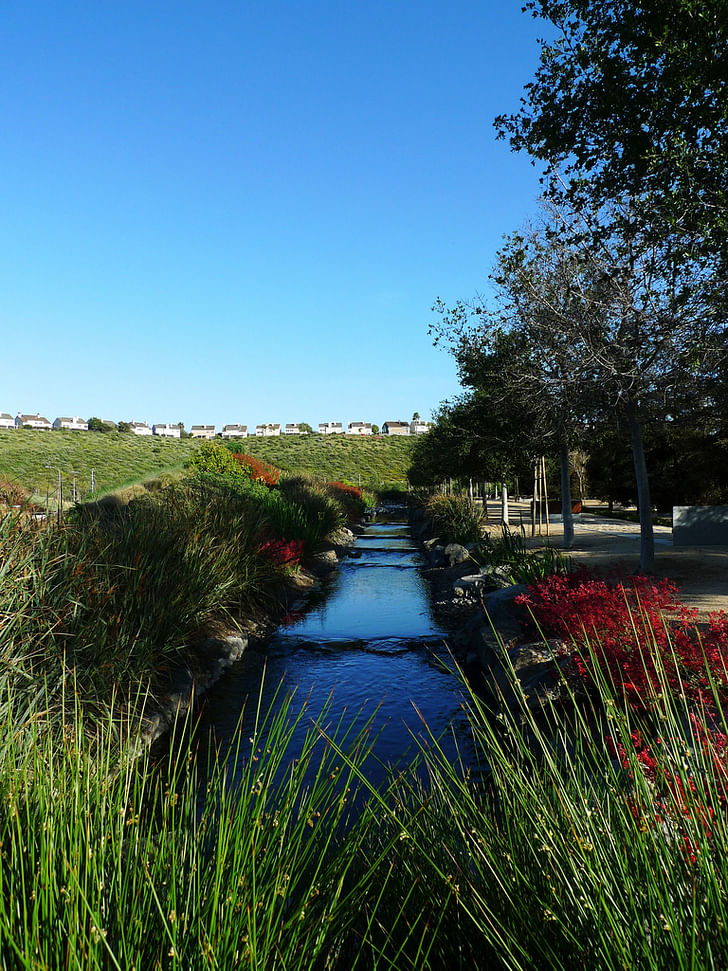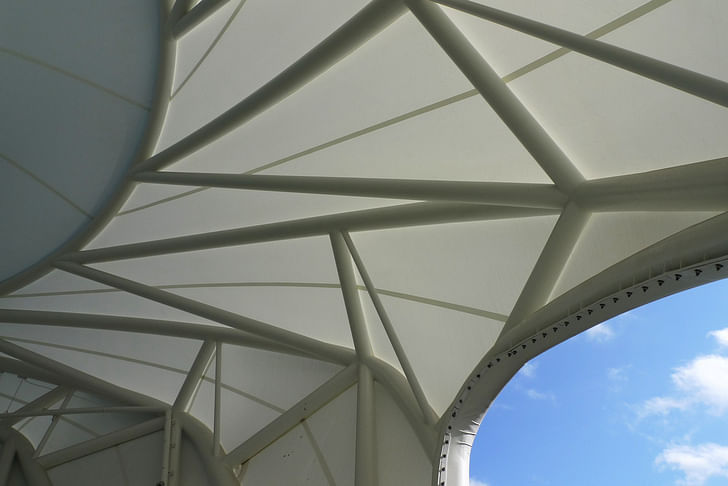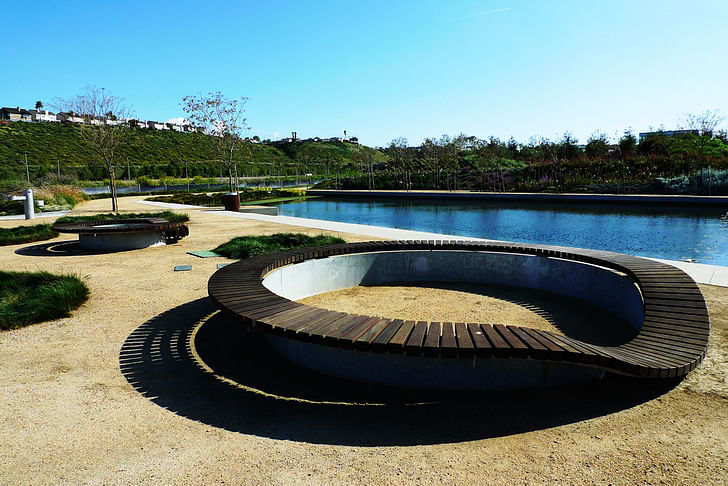

Placed near the east end of continuously expanding Playa Vista, a mixed use development with the marketing strategies and lifestyles of loosely called New Urbanist or thereabouts genre, the newly opened “Central Park“ could be described with the words of my film maker friend as a “designer park,” meant semi ironically and with an admiration for its talented layout and realization.
The Central Park is designed by the office of Michael Maltzan, Architecture and landscape architect James Burnett whose office is well known for corporate open spaces. The project is surrounded by, at least for now, by large empty plots of land sometime to be developed fully, a newly finished business park, another grouping of vacant office buildings on the side and existing buildings of Hughes Aircraft Co., where the famed plywood plane Spruce Goose was constructed. Once the master planned project is completed, the Central Park will be completely surrounded by 4-5 story office buildings with highly controlled entrance and exit points.



The 9 acre site of the park and its larger context of Playa Vista Development is a long story of many things in urban planning and design studies, strategies, process and getting it build and sell. If Playa Vista was a narrative book on private development, its contents page would list headings like; market appetite for up scaled urban housing, Los Angeles style giant land transactions, prime time local political power maneuvers, profit based social engineering, transportation issues, highly contested EIR process, real housewives of Playa Vista, Home Depot urbanism, security operations in semi public developments and a detail chapter on phased occupation and a condominium sales based build out of a large open space in a megalopolis.
Enough cow skinning, don't run away yet... Here is the park, the center piece of this review.



Central Park itself is a beautiful photogenic park with man made topography to achieve variety of relaxing, stimulating outdoor rooms, banks of amphitheaters, artful planting of sustainable native cacti and other flora, compositional and systematically configured artificial alleys and valleys with visual vistas running North and South. These diagonally crisscrossing lines on the plan are called 'bridge' by the architects, visually terminating on the south at vertically edging hillside with 80's ridge housing development more appropriate in Orange County. And, on the north side, same bridges terminating freshly completed and uniformly detached identical and glass walled corporate office buildings.



The notable programs of the park are; ecologically hosting water pools and creeks, popular sports facilities including beach volleyball and basketball courts an artificially carpeted half size soccer field, an engaging children playground, and of course, the most memorable of them all, a turban shaped stage and public bathrooms below, all designed by Michael Maltzan Architects in this interdisciplinary project. The stage enclosure is covered by a transparent synthetic membrane that lights up like a lantern at night and configured from few co-eccentric circles suggestive of turbo like energetic circular movement. Noted is, the park's lighting program that goes beyond municipal lighting of this typology the public is most familiar with.



The park is open to visitors under tight camera and live security guard scrutiny expected of corporate giving. However, this is for some reason is different than other token corporate parks, probably because of its larger size and well taken care of public amenities and the designers' commitment to the public's need for beautiful outdoor spaces.
In my view, freshly inaugurated semi private park is a good negotiated gain for surrounding community's needs and sure to be a successful example of its kind if the similar opportunities rise elsewhere in the city. One can't help but think of many potential developments on the bifurcating arms of the LA River, the long neglected and misused major geographic feature, and on other state and county owned plots in the city.



Park building is the cousin of providing affordable housing for the public as far as planning and design professions are concerned and it is certainly encouraging to see projects of this nature are demanded and developed for the public recreation. Once it is done and used by the community, all else can be redeemed by the music played, children screaming, folks bbq'ing and an average visitor is rejuvenated. Oh yeah, the baby ducks and the rest of the beautiful flora and fauna...
Related links:
Michael Maltzan Architects
Office of James Burnett
Avoiding Regret
Curbed LA on Playa Vista Central Park I
Curbed LA on Playa Vista Central Park II
Playa Vista
Wikipedia entry for San Clemente, CA
Ballona Wetlands Land Trust
All photos by Orhan Ayyüce.
A long-time contributor to Archinect as a senior editor and writing about architecture, urbanism, people, politics, arts, and culture. The featured articles, interviews, news posts, activism, and provocations are published here and on other websites and media. A licensed architect in ...
12 Comments
Great review, and wonderful photos! Nice job Orhan. I'm looking forward to visiting this space next time I find myself on the west side.
thanks paul. let me know when you go. my office is a mile away.
I really like those ovular benches.
This is a great counter-point to my parks interview Orhan. It is interesting that in your judgement it seems a park even semi-private is better than none. The scale working in the citizen's favor in this regard, as you indicate here is a good lesson learned.
Also your ending leads one to believe that post-build programming in terms of usage and communitizing the infrastructure is key to a success/redemption. My question would be what can be done outside of the typical park-lands design (landscape , pavilions etc) to instigate these sorts of negotiated gain in a more generative manner?
nam, if i understood your question, i would answer as, power to the people, community organization, influence the local elected politicians, business and demand additional legislation that favors public explicitly. this culture of 'public' needs take a hold in our society instead of business first and private property ownership trumps everything attitude. process needs to be transparent throughout. and, legislations already in place must be applied fully.
all this is translates as bottom up process of urban policy and design. we need to update the city making process everywhere, small municipalities included.
if i misunderstood your question, maybe you can explain it to me.
Orhan, no you understand perfectly. I guess i just wonder how designers can be best involved? By focusing on community involvement in the design process, as lobbyists (but in good sens a la CUP or CLUI) or just as citizens?
Are there specific design methodologies etc? I completely agree we need a culture of the public, I think recent events in Middle East have highlighted importance of public space. I wonder if there was no Tahrir Square but a Central Park at Playa Vista how events might differ in the sense of occupying and owning "public" space.
I like it! As we say here in the Far East " Maganda" it is beautiful specially the "domic" structure over the bridge!
very nice photos indeed. thanks for this well written review. beautiful architecture, wouldnt mind taking a stroll and checking this place out in real life.
Maltzan in a quote “I didn’t just want it to be something to look at, but more like a college campus, a place where people gathered to work, play, socialise and see a performance.”
Interesting especially in light of current struggles over public space in UC system, related to Occupy movements.
From another review of Playa Vista Central Park in Icon magazine.
ASLA's the DIRT writes that Playa Vista "may now be considered a success story" citing things like preserved wetlands, and other green infrastructure. Regarding the Maltzan project specifically they say "Maltzan’s park provides a sustainable, multi-functional public space bridging the residential and commercial sides, which is also now under development."
One critical point regarding the mixed use nature of the project, "While the development isn’t really the “Live, Work, Play” development it’s sold as — given most of its residents still face a long car ride to their workplaces"
Thanks for the link Nam.
“Live, Work, Play” is whole a lot of bullshit banner used by developers the world over.
DIRT is puffy fluffy. I like this one comment on the linked article. Everything it says is true, especially the traffic jams and the air pollution.
Collateral Damage
Fluff is fluff. It tripled the amount of cars and pollution in the surrounding neighbors that weren’t able to go to six or more lanes like in front of their land. Sitting in traffic so an investment company gets rich, while sticking people on top of methane gas deposits. It was a swamp for a reason even If you dump lots of fill dirt. Then there is the mitigated hazardous materials dumped by Hughes and Tongva burials pushed under sports areas and 10,000 years of life erased for a Discovery Park plaque. The lawsuits by the neighboring cities, environmental and social justice groups were not settled. They and LA lost. Forgive me if I don’t see this as a success.
Re: Playa Vista. I live in the area, and have driven past Playa Vista on Lincoln every business day for the last six years. During the year-long-or-so period that Lincoln was being upgraded, I presume partialy at the Playa Vista developer's expense, there WAS a lot of traffic there. But for the last two years, traffic on Lincoln has returned to normal, and frankly, I thing the general level of traffic in the area is quite light. At the corner of Lincoln and Jefferson, at the height of morning commute, the backup at the signal is quite tolerable by LA standards. The widening of Lincoln has been in my opinion quite successful. Again, in my opinion, the traffic and air pollution complaints are completely overblown. So when you say about the post that "everything it says is true", I'd encourage you to look a little closer. As someone who it there all the time, I don't agree at all.
I like the Maltzan park as an art installation, but I do have a few concerns about it as a functioning park. The first think you see when you arrive is a big sign which lists all the stuff you can't do there. The list is encyclopedic, and includes such antisocial behavior as biking, skateboarding, and "using the facilities for purposes other that for which they were designed". So much for spontaneity. The sign might as well just say "no fun allowed". There's even a sign that says that you are not allowed to retrieve a ball that blows into one of the many lovely ponds on the property. I picture a four-year-old standing at the shore, watching his ball in the center of the pond, tears streaming down his cheeks.
The planting very interesting and creative, but this is potentially the most high-maintenance park public park I've ever seen. When you walk through it, the hand of the designer is everywhere. Everywhere. There is no real "nature" here. It's all carefully, artificially orchestrated. Because of that, it has to be impeccably maintained, or it will look like hell in a few years. Given what typically happens with budgets for maintenance over the lifetime of a public facility, I fear that this park will not age well.
Those swoopy benches are interesting, but I'm not sure what one does with them, other than look at them as sculpture. I first saw them, and thought, "oh, those are designed as chaises, and they are curved for your back to recline on". Wrong, unless you happen to be a giant arthropod. But they do look cool.
My daughter loves the toddler playground area. Maybe the best toddler playground on the Westside.
EKE thanks for the personal review. i think the point about toddler playground telling, perhaps in a good light? maybe in terms of being a used, community, park full of kids? Or is it just best and under-used?
Based on your description of benches I wonder if they might have been intentional unpleasant. Sort of anti-loitering by design as I have recently seen even locally. New upgraded public benches that one can't lay across etc. Although at least here usually takes form of bars and other dividers not just non-anatomical.
Block this user
Are you sure you want to block this user and hide all related comments throughout the site?
Archinect
This is your first comment on Archinect. Your comment will be visible once approved.